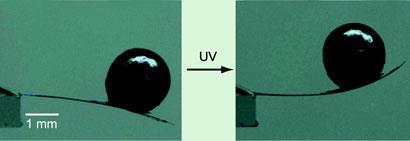Two-component crystal can bend like human muscle to lift weights 600 times greater than its own when exposed to UV light
Japanese researchers have created a co-crystal that reversibly bends like human muscle when exposed to ultraviolet and visible light.1 The material can lift tiny metal balls up to 600 times its own weight and could offer a wireless alternative to current piezoelectric crystals used in microelectromechanical systems (Mems).
In 2007, Masahiro Irie, then at Kyushu University in Japan, demonstrated that a micro-scale crystal (10-100um) comprising photochromic molecules called diarylethenes could expand or bend when hit by UV light.2 The results hinted that tiny light-induced shape changes of individual molecules accumulated to change the overall shape of the crystal. However, the crystals were too fragile and small to be of any use.
Now, Irie and his colleague Masakazu Morimoto, both at Rikkyo University, Japan, have built on this work by creating a two component photo-responsive co-crystal that bends at the macroscale, confirming that light induced molecular-scale events are directly linked to macroscopic movement.
The team made the material, which comprises a diarylethene derivative and perfluoronaphthalene, with dimensions varying between 1-5mm in length, 0.2-1.5mm in width, and 10-50um in thickness. Experiments showed that exposing the material to UV or visible light cause it to bend and was strong enough to lift a 2mm lead ball 275 times heavier than the crystal and a 3mm steel ball around 600 times heavier.

To their surprise, the results indicated that the material was able to withstand stress almost 100 times larger than that of muscles. ’The crystal exhibits large photo-induced maximum stress, around 44MPa, which is comparable to piezoelectric crystals such as lead zirconate titanate,’ Irie says.
’The work could become a classic in the harnessing of controlled molecular motions to do real work on the macroscopic scale,’ comments Amar Flood who investigates the mechanical properties of materials at the molecular level at Indiana University in Bloomington, US. ’Precious few, if any other molecular systems have achieved this performance other than real muscles.’ The work could offer a new way to design photomechanical materials that rely on the controlled movement of individual molecules as opposed to polymer based designs, Flood adds.
Possible Mems applications include wireless manipulation of biological cells and light-driven valves in microreactors, suggests Irie. ’The crystal could replace present piezoelectric crystals in Mems because the crystal performs the work without electric-wire connections.’
James Urquhart
References
J. Am. Chem. Soc.10.1021/ja105356wet alNature446, 778 (DOI: 10.1038/nature05669)






No comments yet